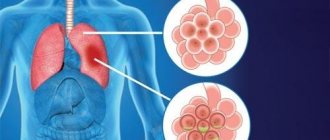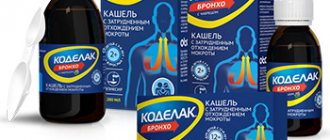Is it possible to swallow phlegm in the throat?
The accumulation of mucus in the throat forces the patient to pay attention to it.
There are only two options: expectoration or swallowing. Both processes are physiological. Swallowing is harmless: sputum passes into the stomach and is broken down into components. Enzymes in the gastric juice transform mucus into water, which returns to the body and brings only benefits. Harmful components are digested and excreted naturally.
The feeling of mucus in the throat due to hypersecretion of the glands of the respiratory system is normal. These nerve endings signal stagnation of phlegm. The main thing is the absence of suffocation, which is a dangerous sign of the development of events: swelling of the larynx with a threat to life.
Sputum in the lungs by composition
Accumulations of mucus in infants
Many mothers begin to worry when their baby develops mucus in the nasopharynx. For children of this age, this is a very common phenomenon, since their respiratory system is not yet fully formed. But sometimes such a symptom can actually indicate the presence of a certain disease.
Maybe
Coughing up white mucus without coughing
Enveloping the larynx with white mucus without a reflexive attempt to remove it is a common reason for patients to see a doctor. Most often, this is pure physiology, not dangerous to health: unfavorable ecology, food irritating the mucous membranes, alcoholic drinks.
If, in addition to sputum, cold symptoms appear: runny nose, headache and fever, this is a reason to consult a doctor.
Most likely, acute respiratory infections provoked an exacerbation of a latent process, which is localized in the upper respiratory tract and does not manifest itself in anything other than hypersecretion of mucus. The pathology does not descend into the bronchi, so there is no cough. But such “innocence” may hide tumors of the nasopharynx, so consultation with a specialist is necessary.
For prevention purposes, any expectoration of white mucus without coughing for a couple of days is a reason to visit a therapist.
An examination with special equipment and a series of tests will allow you to determine the true cause of hypersecretion and prescribe therapy or send you to a specialized specialist.
How to remove nighttime mucus drainage
During the daytime, the clinical manifestations of the disease are less pronounced, since the body is in an upright position. The person simply swallows the bulk of the discharge. At night, when the body is in the “lying” position, mucus flows to the reflexogenic areas of the laryngopharynx. This irritates them and leads to severe coughing. For this reason, nighttime mucus discharge causes serious discomfort and interferes with normal rest.
To get rid of the problem, you need to identify its cause by contacting a specialist. The doctor may prescribe rinsing the nasal cavity, irrigating the nose with a spray with silver ions, or steam inhalation. You should also keep your sleeping area humid and drink plenty of fluids to help relieve postnasal drip at night.
Other reasons
If sputum accumulates in the throat due to allergies, then you should take antihistamines (Suprastin, Cetirizine, Loratadine, Tavegil). Relief should occur within the first day of using them. If the symptom is caused by reflux and reflux of stomach contents, then treatment is prescribed by a gastroenterologist.
It will be individual for each patient (with the use of enzymes, anti-inflammatory drugs and dopamine receptor blockers).
You will also be interested in:
- How to treat a dry cough in an adult that lasts for a long time without fever
Why is the nasal septum deviated?
The cartilage tissue that represents the septum does not have such a dense structure as bone, so it is prone to deformation as a result of injuries, falls, and also against the background of long-term inflammatory processes. The septum consists of quadrangular cartilage and three bones - the perpendicular plate, the vomer and the premaxillary bone from the upper jaw. It is curved due to the fact that there is a discrepancy in the growth of the cartilaginous part and the bone part - something grows faster and, since there is nowhere to grow, goes to the side, or there was an injury, and because of this the septum is bent. Therefore, there are deviated septums without injury.
Until the age of 21, a person’s cartilage tissue still continues to grow, so surgical intervention is considered unacceptable. In many cases, natural self-correction is possible during the growth process. The septum is now operated on at any age, despite the fact that it grows. But if the septum is severely deviated, surgery is performed at any age, including children.
Despite encouraging forecasts, damage not only to the septum itself, but also to internal structures is possible. As a result of such deformation of the internal cavity, serious chronic processes develop, characterized by the accumulation of mucus inside. In this way, indications for surgical intervention are formed.
Causes caused by pathological processes
Green sputum without cough is always the cause of an infectious disease. It can form or accumulate in the throat with the following pathologies:
- pharyngitis (inflammation of the larynx);
- rhinitis (inflammation of the nasal mucosa);
- nasopharyngitis (inflammation of the nasopharynx);
- bronchial or pulmonary diseases (usually chronic);
- tonsillitis (inflammation of the tonsils);
- allergy.
Most often, the feeling of phlegm in the throat occurs in people who suffer from laryngopharyngeal reflux or esophagitis.
Mucus drains from the nose down the back of the throat. Or it is thrown from the lower respiratory tract, esophagus. Irritation that occurs inside the pharynx increases the formation of sputum.
Viral and bacterial diseases that cause excess mucus in the throat are often accompanied by elevated body temperature. When fluid comes back from the esophagus, there is an unpleasant taste in the mouth.
Video
This video talks about the reasons for the appearance of mucus in the nasopharynx.
If you have already discovered an addiction, then you need to contact a pediatric ENT doctor about this problem. There can be many reasons for the formation of mucus in the nasopharynx in both adults and children. It is very important to recognize and eliminate them in time. Look after your health and carry out preventive measures during the period, then you will not be afraid of any permanent diseases, let alone complications. What is chronic bronchitis code according to ICD-10 can be read at the following link.
Possible causes of sputum without cough and additional symptoms
Sputum is mucus that is secreted by glandular cells of the trachea, nasal cavity, paranasal sinuses and bronchi. Normally, no more than 100 ml of mucus accumulates in the tracheobronchial tree per day. It has bactericidal properties and is involved in the removal from the respiratory tract:
- dust;
- allergens;
- pathogenic agents.
When the mucous membrane is irritated, the activity of glandular cells increases 10 times or more.
Therefore, in case of illness, up to 4 liters of pathological sputum are produced per day. Expectoration of mucus without coughing is a nonspecific symptom that accompanies pathologies of various systems:
- respiratory;
- digestive;
- endocrine;
- nervous.
To find out the cause of the condition, you need to determine:
- the nature of sputum - elasticity, transparency, color, smell;
- associated symptoms – chest pain, sore throat, burning sensation in the nose;
- factors that provoke exacerbation are strong odors, physical activity, drinking hot drinks, etc.
Expectoration of mucus without coughing in half of the cases indicates damage to the nasopharynx or bronchopulmonary system.
Sinusitis and rhinitis
Thick mucus is released without coughing in case of inflammation of the nasopharynx and paranasal sinuses. Copious sputum is expectorated in the following diseases:
- The best cough syrup for children from all types
- Rhinitis (runny nose). Inflammation of the nasal mucosa is accompanied by the secretion of viscous mucus. Its transparency and elasticity depend on the form of the disease. An infectious runny nose produces yellow or green mucus. In people with insufficient tone of blood vessels, vasomotor rhinitis occurs, in which a transparent secretion is formed. With atrophic rhinitis, foul-smelling green sputum occurs.
- Sinusitis. When the maxillary sinuses become inflamed, sinusitis occurs, the ethmoid sinuses - ethmoiditis, the sphenoid sinuses - sphenoiditis, and the frontal sinuses - frontal sinusitis. If you cough up white, thick mucus without coughing, the cause of the illness is a viral infection or allergy. With bacterial and fungal inflammation, it acquires a yellow or green tint and an unpleasant odor.
Expectoration of mucus without coughing occurs mainly in the morning, as during the night it flows down the back wall of the throat into the hypopharynx.
Pharyngitis, laryngitis, tonsillitis
Phlegm in the throat without cough in children and adults occurs due to inflammation:
- palatine tonsils – tonsillitis;
- pharynx – pharyngitis;
- larynx - laryngitis.
If the secretion is transparent, this indicates the onset of the disease or the attenuation of inflammation. In the absence of complications, the cough does not bother you, and small amounts of sputum are expectorated. If it becomes thick and green, purulent inflammation is possible.
The release of viscous mucus without coughing after laryngitis is a sign that the inflammation has become chronic.
Reflux esophagitis
If there is no cough, but there is sputum in an adult, the cause may be the reflux of gastric contents into the esophagus - gastroesophageal reflux disease (GERD). Gastric juice contains hydrochloric acid, which irritates the mucous membrane and provokes the production of mucus.
GERD manifests itself:
- heartburn;
- sour taste in the mouth;
- swallowing disorder;
- hoarseness of voice;
- heaviness in the stomach after eating.
GERD is characterized by insufficiency of the esophageal sphincter.
The contents of the stomach enter the esophagus when the body is tilted or in a supine position. Therefore, clear mucus is coughed up after waking up. If you accidentally inhale gastric juice, a spasmodic cough occurs, accompanied by a burning sensation in the laryngopharynx.
Tuberculosis and other lung infections
Viscous mucus accumulates in the respiratory tract during infectious inflammation of the bronchi and lungs. Green sputum occurs when the ENT organs are damaged:
- Koch's bacillus;
- adenovirus;
- Staphylococcus aureus;
- pneumococcus;
- coronavirus;
- measles virus;
- peptostreptococcus;
- pyogenic streptococcus;
- corynebacterium.
Pathogenic microorganisms produce toxins, so signs of intoxication (poisoning) come to the fore:
- weakness;
- lack of appetite;
- headache;
- drowsiness;
- sweating
With viral inflammation, the sputum is clear, with bacterial inflammation it is yellow, and with purulent inflammation it is green.
If there is no cough and mucus accumulates in the bronchi, breathing becomes harsh. When listening with a stethoscope, moist rales are heard in the lungs.
Allergy
Sputum production without coughing is one of the signs of a respiratory allergy. Irritants (allergens) are:
- medicines;
- plant pollen;
- Food;
- fumes from household chemicals;
- dust mites.
Manifestations of respiratory allergies:
- Night cough in children and adults - causes of dry and wet cough, diagnosis and treatment methods
- labored breathing;
- redness of the throat mucosa;
- nasal congestion;
- lacrimation (with hay fever);
- pain when swallowing;
- hoarseness of voice.
Depending on the location of the inflammation, the allergy occurs with or without a cough.
Patients complain of expectoration of clear, viscous sputum, which sometimes becomes glassy. In the absence of treatment, the clinical picture is supplemented by new symptoms - spasmodic cough, shortness of breath, swelling of the mucous membranes.
Bronchitis
With inflammation of the bronchi, the production of bronchial secretions increases 5-7 times. At the initial stage, the cough appears and then disappears. When accumulated mucus irritates the receptors, coughing attacks occur. Without taking mucolytics, she does not expectorate, so wheezing appears in the lungs.
Symptoms of bronchitis:
- malaise;
- hard breathing;
- chest discomfort;
- nasal congestion;
- moderate increase in temperature.
After 2-3 days, the mucus begins to come out abundantly, so a productive cough occurs. It intensifies at night or in the morning, with a sharp change in temperature.
Sjögren's syndrome
Sputum without fever and cough is one of the signs of Sjögren's disease. It is characterized by damage to connective tissue and exocrine glands. Accompanied by sinusitis and tracheobronchitis, separation of rusty sputum.
Symptoms of Sjögren's disease:
- muscle and joint pain;
- dry eyes;
- seizures in the corners of the mouth;
- violation of the act of swallowing;
- prostration;
- dry tongue;
- formation of crusts in the nose;
- enlargement of the parotid glands.
The mucous membrane of the throat dries out and acquires a bright red tint.
If the glands are insufficient, the saliva becomes viscous. Due to dysphagia (impaired swallowing), the patient cannot swallow it. Therefore, there is a feeling of mucus accumulation in the throat.
Inflammation of the adenoids
Sputum without cough in a child appears against the background of adenoiditis. This is the name for inflammation of an enlarged nasopharyngeal tonsil. The adenoids block the nasal passages, so viscous secretions accumulate in the nasal cavity. During sleep, it flows into the throat through the back wall of the pharynx.
Manifestations of adenoiditis:
- night snoring;
- violation of nasal breathing;
- coughing up yellow mucus;
- restless sleep;
- headache;
- elevated temperature.
There is no cough while awake. It occurs in the morning or immediately after waking up due to irritation of the throat by nasal secretions. If left untreated, the Eustachian tube becomes inflamed (eustachitis), so the child complains of decreased hearing acuity and ear pain.
Esophageal diverticulum
An esophageal diverticulum is a saccular bulge in the wall of the esophagus. It manifests itself as dysphagia, bad breath, and a feeling of a lump in the throat. Many people experience hypersalivation - excessive production of saliva, so they complain of copious sputum discharge without coughing attacks.
Associated symptoms depend on the location of the diverticulum. The most striking clinical picture when a protrusion forms in the clavicle area:
- change in voice timbre;
- nausea;
- scratching in the throat;
- expectoration of thin sputum;
- regurgitation of food;
- backflow of mucus from the esophagus into the throat.
Large diverticula put pressure on the respiratory system, causing coughing. It is combined with chest pain and dizziness.
Consequences of smoking
Non-infectious bronchitis is a problem faced by smokers with more than 7 years of experience. Systematic damage to the bronchi by tobacco smoke leads to irritation and inflammation of the mucous membrane, which increases the activity of glandular cells.
Symptoms of smoker's bronchitis:
- rawness in the throat;
- occasional cough;
- mucus department;
- dyspnea;
- hard breathing;
- tachycardia (against the background of coughing attacks).
During the day, sputum passes without coughing. But during sleep, it accumulates in the throat, so in the morning coughing attacks occur, during which clots of transparent mucus are released.
Worm infestation
If a child or adult does not cough up clear or white sputum, the cause may be helminthiasis. In the acute phase, parasite larvae circulate in the blood and enter the bronchi. They irritate the mucous membrane, causing a productive cough. A person complains about:
- chest pain;
- swelling of the mucous membranes;
- shortness of breath;
- nausea.
When the mucus is swallowed, the worms enter the intestines, where they develop into adults. In the later stages, helminthiasis manifests itself:
- abdominal pain;
- unstable stool;
- weakness;
- sleep disturbance;
- elevated temperature;
- convulsions.
With a chronic disease, immunity decreases, so rhinitis, tracheitis, and influenza often recur.
Other reasons
Foul-smelling mucus without coughing is a dangerous symptom that occurs against the background of purulent inflammation of the ENT organs. Without treatment, complications are possible - abscess and gangrene of the lung, sepsis (blood poisoning).
Possible causes of expectoration:
- lungs' cancer;
- pulmonary syphilis, disintegration of syphilitic gum;
- bronchopulmonary carcinoma;
- cystic fibrosis;
- pulmonary mycosis;
- actinomycosis;
- bullous disease;
- pleural empyema;
- COPD
Yellow sputum without cough is a sign of bacterial diseases of the nasopharynx. If clots of dried blood are found in it, this indicates mucopurulent inflammation. Brown sputum in the morning without cough occurs with bronchiectasis and cardiac pathologies.
Why does mucus accumulate and can drain and smell in children?
Children's rhinitis is a common symptom of a cold, which very often affects the children's body. Such a symptom cannot be ignored, and to avoid the formation of serious complications, begin treatment immediately.
White
In young patients, when blowing their nose, parents discover white mucus. The reason for its formation lies in allergies. In addition to the fact that the mucus (or clot) is white, it is also viscous, viscous and can smell. The following reasons may influence the formation of allergies:
- pet fur;
- dust and very dry air;
- microorganisms that live in fleecy carpets or bedding.
To determine the exact cause of the allergy and the associated whitish nasal discharge, it is necessary for the baby to undergo a blood test. Then it will be possible to identify the allergen and prescribe it a course of antihistamine therapy.
How to properly use the sinusitis spray is indicated here.
Viscous
A poor environmental background can contribute to the accumulation of thick mucus. The baby's body actively produces mucus, which the nasal mucosa needs to prevent the negative effects of various microorganisms. The result of a large accumulation of bacteria and viruses is thick mucus. It is produced by mucin proteins and also consists of water and salt. It is this protein that is responsible for the consistency of nasal discharge. Most often, thick snot in a child is a sign of hypothermia and allergies.
You can read in detail about the use of a spray for allergic rhinitis in this material.
Green nasal discharge
The color of snot can indicate the stage and type of disease that caused it. Very often, parents begin to panic when the baby secretes green mucus. In fact, this is not a good sign, since it indicates the presence of a dangerous illness.
The following pathologies most often contribute to the release of green mucus:
- Purulent runny nose
. This disease is a complication of viral-type acute respiratory infections. Purulent rhinitis greatly weakens children's immunity, and these are ideal conditions for the development of a secondary bacterial infection. This condition cannot be cured with solutions and plenty of drinking alone, so parents should not allow the pathological process to develop. - Sinusitis
. In addition to the fact that green mucus is released from the nose, the baby’s sensitivity to taste buds decreases. The lesion can be caused not only to one, but also to both sides of the nasopharynx. The baby may have a fever, pain in the area of the affected sinus, pain in the head, which intensifies when the child takes a position lying on his back. - Frontit
. When the body is affected, the baby develops symptoms characteristic of sinusitis. The difference between these pathologies is that frontal sinusitis causes pain in the nasal sinus that is affected by the infection. - Ethmoiditis
. This disease can occur due to untimely treatment of rhinitis. The infection affects the paranasal sinuses, located in the ethmoid labyrinth. In addition to painful sensations, the baby may develop a fever, runny nose, and nasal congestion.
The link shows the causes and treatment of a sore throat.











